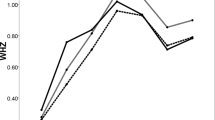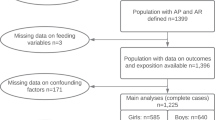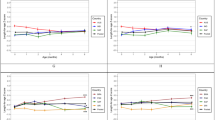Abstract
Objectives:
The effect of breastfeeding duration on the prevalence of overweight and on mean weight for height z-score (WHZ) was evaluated in Brazilian children.
Design:
Prospective population-based birth cohort study.
Subjects:
In total, 1273 children aged 4 years, corresponding to a follow-up rate of 87.2%.
Measurements:
Three explanatory variables were studied: duration of any breastfeeding, duration of exclusive or predominant breastfeeding, and ever breastfeeding. Weight and height were measured using a digital electronic scale and a portable stadiometer. Overweight was defined as WHZ >2 using the National Center for Health Statistics reference curve.
Results:
Overweight prevalence at the age of 4 years was 10.2% (95% CI 8.4; 11.8). The lowest prevalence (6.5%) was observed among children breastfed for >11 months. Among those breastfed for less than 3 months, the prevalence of overweight was approximately 9.5%. Mean WHZ ranged from 0.38 among children breastfed for less than 1 month to 0.62 among those breastfed for 9–11.9 months. No linear trends were detected in the association between breastfeeding and anthropometric indicators. None of the three breastfeeding variables was significantly associated with the prevalence of overweight or mean WHZ in multivariable analyses. No interactions were detected between breastfeeding and the variables sex, birth weight, socioeconomic status, skin color and pregestational in body mass index.
Conclusion:
Our results do not support the hypothesis that breastfeeding promotion would reduce overweight or obesity in this population. Existing evidence on many other benefits of breastfeeding for the mother and the child supports its continued promotion, protection and support.
This is a preview of subscription content, access via your institution
Access options
Subscribe to this journal
Receive 12 print issues and online access
$259.00 per year
only $21.58 per issue
Buy this article
- Purchase on Springer Link
- Instant access to full article PDF
Prices may be subject to local taxes which are calculated during checkout

Similar content being viewed by others
References
de Onis M, Blossner M . Prevalence and trends of overweight among preschool children in developing countries. Am J Clin Nutr 2000; 72: 1032–1039.
Strauss RS, Pollack HA . Epidemic increase in childhood overweight, 1986–1998. JAMA 2001; 286: 2845–2848.
Lindstrom M, Isacsson SO, Merlo J . Increasing prevalence of overweight, obesity and physical inactivity: two population-based studies 1986 and 1994. Eur J Public Health 2003; 13: 306–312.
Lake JK, Power C, Cole TJ . Child to adult body mass index in the 1958 British birth cohort: associations with parental obesity. Arch Dis Child 1997; 77: 376–381.
Power C, Lake JK, Cole TJ . Body mass index and height from childhood to adulthood in the 1958 British born cohort. Am J Clin Nutr 1997; 66: 1094–1101.
Power C, Lake JK, Cole TJ . Measurement and long-term health risks of child and adolescent fatness. Int J Obes Relat Metab Disord 1997; 21: 507–526.
Serdula MK, Ivery D, Coates RJ, Freedman DS, Williamson DF, Byers T . Do obese children become obese adults? A review of the literature. Prev Med 1993; 22: 167–177.
Whitaker RC, Wright JA, Pepe MS, Seidel KD, Dietz WH . Predicting obesity in young adulthood from childhood and parental obesity. N Engl J Med 1997; 337: 869–873.
James PT, Rigby N, Leach R . The obesity epidemic, metabolic syndrome and future prevention strategies. Eur J Cardiovasc Prev Rehabil 2004; 11: 3–8.
World Health Organization. Effect of breastfeeding on infant and child mortality due to infectious diseases in less developed countries: a pooled analysis. WHO Collaborative Study Team on the Role of Breastfeeding on the Prevention of Infant Mortality. Lancet 2000; 355: 451–455.
Gillman MW, Rifas-Shiman SL, Camargo Jr CA, Berkey CS, Frazier AL, Rockett HR et al. Risk of overweight among adolescents who were breastfed as infants. JAMA 2001; 285: 2461–2467.
Liese AD, Hirsch T, von Mutius E, Keil U, Leupold W, Weiland SK . Inverse association of overweight and breast feeding in 9 to 10-y-old children in Germany. Int J Obes Relat Metab Disord 2001; 25: 1644–1650.
Tulldahl J, Pettersson K, Andersson SW, Hulthen L . Mode of infant feeding and achieved growth in adolescence: early feeding patterns in relation to growth and body composition in adolescence. Obes Res 1999; 7: 431–437.
von Kries R, Koletzko B, Sauerwald T, von Mutius E, Barnert D, Grunert V et al. Breast feeding and obesity: cross sectional study. BMJ 1999; 319: 147–150.
Baranowski T, Bryan GT, Rassin DK, Harrison JA, Henske JC . Ethnicity, infant-feeding practices, and childhood adiposity. J Dev Behav Pediatr 1990; 11: 234–239.
Zive MM, McKay H, Frank-Spohrer GC, Broyles SL, Nelson JA, Nader PR . Infant-feeding practices and adiposity in 4-y-old Anglo- and Mexican-Americans. Am J Clin Nutr 1992; 55: 1104–1108.
Victora CG, Barros F, Lima RC, Horta BL, Wells J . Anthropometry and body composition of 18 year old men according to duration of breast feeding: birth cohort study from Brazil. BMJ 2003; 327: 901.
Li L, Parsons TJ, Power C . Breastfeeding and obesity in childhood: cross-sectional study. BMJ 2003; 327: 904–905.
Eid EE . Follow-up study on physical growth of children who had excessive weight gain in first six months of life. BMJ 1970; 2: 74–76.
Dewey KG, Heining MJ, Nommsen LA, Peerson JM, Lonnerdal B . Breastfed infants are leaner than formula-fed infants at 1 y of age: the DARLING study. Am J Clin Nutr 1993; 57: 140–145.
Elliott KG, Kjolhede CL, Gournis E, Rasmussen KM . Duration of breastfeeding associated with obesity during adolescence. Obes Res 1997; 5: 538–541.
Dewey KG . Is breastfeeding protective against child obesity? J Hum Lact 2003; 19: 9–18.
Arenz S, Ruckerl R, Koletzko B, von Kries R . Breast-feeding and childhood obesity – a systematic review. Int J Obes Relat Metab Disord 2004; 28: 1247–1256.
Owen CG, Martin RM, Whincup PH, Smith GD, Cook DG . Effect of infant feeding on the risk of obesity across the life course: a quantitative review of published evidence. Pediatrics 2005; 115: 1367–1377.
Armstrong J, Reilly JJ . Breastfeeding and lowering the risk of childhood obesity. Lancet 2002; 359: 2003–2004.
Klackenberg G, Klackenberg-Larsson I . The development of children in a Swedish urban community. A prospective longitudinal study. V. Breast-feeding and weaning: some social-psychological aspects. Acta Paediatr Scand Suppl 1968; 187: 94–104.
Yang Q, Wen SW, Dubois L, Chen Y, Walker MC, Krewski D . Determinants of breast-feeding and weaning in Alberta, Canada. J Obstet Gynaecol Can 2004; 26: 975–981.
World Bank. Round II: Country Reports on Health, Nutrition, Population Conditions among Poor and Better-Off in 56 Countries: World Bank, 2004.
Victora CG, Barros FC, Kirkwood BR, Vaughan JP . Pneumonia, diarrhoea and growth in the first four years of life. A longitudinal study of 5,914 Brazilian infants. Am J Clin Nutr 1990; 52: 391–396.
World Health Organization Expert Committee. Physical status, the use and interpretation of anthropometry. World Health Organization: Geneva, 1995.
Grummer-Strawn LM, Mei Z . Does breastfeeding protect against pediatric overweight? Analysis of longitudinal data from the Centers for Disease Control and Prevention Pediatric Nutrition Surveillance System. Pediatrics 2004; 113: 81–86.
Jain A, Concato J, Leventhal JM . How good is the evidence linking breastfeeding and intelligence? Pediatrics 2002; 109: 1044–1053.
Post CL, Victora CG, Barros FC, Horta BL, Guimarães PRV . Infant malnutrition and obesity in two population-based birth cohort studies in southern Brazil: trends and differences. Cad Saúde Pública 1996; 12: S49–S57.
Monteiro CA, Moura EC, Conde WL, Popkin BM . Socioeconomic status and obesity in adult populations of developing countries: a review. Bull World Health Organ 2004; 82: 940–946.
Bergmann KE, Bergmann RL, Von Kries R, Bohm O, Richter R, Dudenhausen JW et al. Early determinants of childhood overweight and adiposity in a birth cohort study: role of breast-feeding. Int J Obes Relat Metab Disord 2003; 27: 162–172.
Acknowledgements
This analysis was supported by the Wellcome Trusts initiative entitled Major Awards for Latin America on Health Consequences of Population Change. Earlier phases of the 1993 cohort study were funded by the European Union, the National Program for Centers of Excellence (Brazil), the National Research Council (Brazil) and the Ministry of Health (Brazil).
Author information
Authors and Affiliations
Corresponding author
Additional information
Supplementary Information accompanies the paper on International Journal of Obesity webiste (http://www.nature.com/ijo)
Supplementary information
Rights and permissions
About this article
Cite this article
Araújo, C., Victora, C., Hallal, P. et al. Breastfeeding and overweight in childhood: evidence from the Pelotas 1993 birth cohort study. Int J Obes 30, 500–506 (2006). https://doi.org/10.1038/sj.ijo.0803160
Received:
Revised:
Accepted:
Published:
Issue Date:
DOI: https://doi.org/10.1038/sj.ijo.0803160
Keywords
This article is cited by
-
Modifiable risk factors in the first 1000 days for subsequent risk of childhood overweight in an Asian cohort: significance of parental overweight status
International Journal of Obesity (2018)
-
Alarming high prevalence of overweight/obesity among Sudanese children
European Journal of Clinical Nutrition (2011)
-
Exclusive breastfeeding of Swedish children and its possible influence on the development of obesity: a prospective cohort study
BMC Pediatrics (2008)
-
Prevalence and Determinants of Obesity in Children in Public Schools of Sintra, Portugal
Obesity (2008)
-
Influence of the family nucleus on obesity in children from northeastern Brazil: a cross-sectional study
BMC Public Health (2007)



